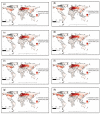Climate Change Influences the Spread of African Swine Fever Virus
- PMID: 36356083
- PMCID: PMC9698898
- DOI: 10.3390/vetsci9110606
Climate Change Influences the Spread of African Swine Fever Virus
Abstract
Climate change is an inevitable and urgent issue in the current world. African swine fever virus (ASFV) is a re-emerging viral animal disease. This study investigates the quantitative association between climate change and the potential spread of ASFV to a global extent. ASFV in wild boar outbreak locations recorded from 1 January 2019 to 29 July 2022 were sampled and investigated using the ecological distribution tool, the Maxent model, with WorldClim bioclimatic data as the predictor variables. The future impacts of climate change on ASFV distribution based on the model were scoped with Representative Concentration Pathways (RCP 2.6, 4.5, 6.0, and 8.5) scenarios of Coupled Model Intercomparison Project 5 (CMIP5) bioclimatic data for 2050 and 2070. The results show that precipitation of the driest month (Bio14) was the highest contributor, and annual mean temperature (Bio1) was obtained as the highest permutation importance variable on the spread of ASFV. Based on the analyzed scenarios, we found that the future climate is favourable for ASFV disease; only quantitative ratios are different and directly associated with climate change. The current study could be a reference material for wildlife health management, climate change issues, and World Health Organization sustainability goal 13: climate action.
Keywords: ASFV; Maxent; disease; management; wildlife.
Conflict of interest statement
The authors declare no conflict of interest.
Figures




Similar articles
-
Predicting the potential distribution of Amblyomma americanum (Acari: Ixodidae) infestation in New Zealand, using maximum entropy-based ecological niche modelling.Exp Appl Acarol. 2020 Feb;80(2):227-245. doi: 10.1007/s10493-019-00460-7. Epub 2020 Jan 21. Exp Appl Acarol. 2020. PMID: 31965414 Free PMC article.
-
Ecological niche modeling based on ensemble algorithms to predicting current and future potential distribution of African swine fever virus in China.Sci Rep. 2022 Sep 16;12(1):15614. doi: 10.1038/s41598-022-20008-x. Sci Rep. 2022. PMID: 36114368 Free PMC article.
-
Optimising response to an introduction of African swine fever in wild pigs.Transbound Emerg Dis. 2022 Sep;69(5):e3111-e3127. doi: 10.1111/tbed.14668. Epub 2022 Aug 9. Transbound Emerg Dis. 2022. PMID: 35881004
-
African Swine Fever: Disease Dynamics in Wild Boar Experimentally Infected with ASFV Isolates Belonging to Genotype I and II.Viruses. 2019 Sep 13;11(9):852. doi: 10.3390/v11090852. Viruses. 2019. PMID: 31540341 Free PMC article. Review.
-
African Swine Fever Virus: An Emerging DNA Arbovirus.Front Vet Sci. 2020 May 13;7:215. doi: 10.3389/fvets.2020.00215. eCollection 2020. Front Vet Sci. 2020. PMID: 32478103 Free PMC article. Review.
Cited by
-
A Systematic Literature Review of Variables Associated with the Occurrence of African Swine Fever.Viruses. 2025 Jan 30;17(2):192. doi: 10.3390/v17020192. Viruses. 2025. PMID: 40006950 Free PMC article.
-
African swine fever virus: Virology, pathogenesis, clinical impact, and global control strategies.Vet World. 2025 Jun;18(6):1599-1613. doi: 10.14202/vetworld.2025.1599-1613. Epub 2025 Jun 16. Vet World. 2025. PMID: 40689197 Free PMC article. Review.
-
Distribution of sika deer (Cervus nippon) and the bioclimatic impact on their habitats in South Korea.Sci Rep. 2023 Nov 3;13(1):19040. doi: 10.1038/s41598-023-45845-2. Sci Rep. 2023. PMID: 37923751 Free PMC article.
-
Tick-Borne Viruses in a Changing Climate: The Expanding Threat in Africa and Beyond.Microorganisms. 2025 Jun 28;13(7):1509. doi: 10.3390/microorganisms13071509. Microorganisms. 2025. PMID: 40732018 Free PMC article. Review.
-
Spatiotemporal Patterns of African Swine Fever in Wild Boar in the Russian Federation (2007-2022): Using Clustering Tools for Revealing High-Risk Areas.Animals (Basel). 2023 Oct 2;13(19):3081. doi: 10.3390/ani13193081. Animals (Basel). 2023. PMID: 37835687 Free PMC article.
References
-
- Plavšic B., Rozstalnyy A., Park J.Y., Guberti V., Depner K.R., Torres G. Strategic Challenges to Global Control of African Swine Fever; Proceedings of the General Sessions on the World Assembly of the Delegates of the OIE; Paris, France. 26–31 May 2019; pp. 26–31.
LinkOut - more resources
Full Text Sources

